The Museum Collections
Introduction
I. History and Art Collection
1. Icons of the 14th – 19th centuries
icons of the 14th – 17th century
2. Jewelry art of the 14th – 20th century
jewelry art of the 14th – 17th century
jewelry art of the 18th – 19th century
the european silver 14th - 19th centuries
3. Small-size sculptures (works of metal, wood, bone)
XI – the beginning of the XX century
Small-size sculptures 11th – 17th century
Small-size sculptures 18th – early 20th century
enamel of Troitza masters 15-8th – early 20th century
5.Embroidery, lace, textiles of the 14th - early 20th century
icon and ornamental embroidery
gold and silver lace
6.Painting of the 18th – 21st centuries
painting of the 18th – 19th centuris
painting of the 20th – 21st centuris
II.Manuscripts and old printed books of the 14th – 17th century
IV.Lithography of the 18th – 19th century
V.Numismatics
VI.Medals of the 18th - early 20th century
VIII.Archeology collection
IX. Russian folk and applied and decorative art of the 17th – 21st c.
1. Artistic wood
folk carved and painted wood
wooden toys
house carving of Sergiev Posad
Khokhloma and Gorodets painting
2. Artistic textiles
embroidery and weaving
printed textiles and lace
Russian shawls
folk costumes
folk garments
printed cotton kerchiefs
|
The numismatics collection(p.1) |
The collection of numismatics of the Sergiev-Posad museum totals about 8000 subjects. Its basis was the coins, which have arrived in a museum from the Trinity-St.Sergius Laura. To them were added coins from A.A.Aleksandrov's collection, receipt from private persons and a small amount of coins from archeological excavations. The overwhelming majority of a collection made up the Russian coins. They presented full enough, and cover the time from 12th to the middle of 20th centuries.
The earliest Old Russian monetary sign in our collection is the Novgorod “grivna”, which is dated 12th century (Ill.1). The Novgorod grivnas in the form of long silver sticks in weight nearby 200 g had the greatest value in monetary circulation in Russia at first on the northwest Russian earths, and from the middle of 13th century - in all territory of the Old Russian state
In history of Russian monetary circulation, the period of 12-14th centuries, has received name «coinless». The principal cause of absence stamping of coins, probably, it is necessary to consider the begun feudal dissociation of Russia, that liquidated a uniform economic and political basis of the organisation of monetary manufacture and monetary circulation. Only in second half of 14th century in a number of Russian princedoms stamping of the coin has again begun in connection with requirements of restored commodity manufacture of Russia and for obvious communication with strengthening of emancipating struggle against conquerors. The coin has called «denga». This name has generated soon after the occurrence and collective Russian concept "dengi" (money). In a museum collection are stored coins of Mozhaysk, Vereysk, Serpukhov, Zvenigorod specific princedoms and a great Moscow princedom of time of Vasily II, Ivan III and Vasily III (Ill. 2).
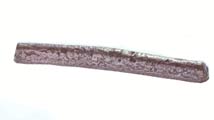
1.Grivna. 12th century. Silver.
|
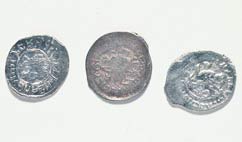
2. Coins of appanage princedoms. 15th century. Silver.
|
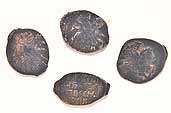
3.Kopecks of tzar Ivan IV Grozny. 1533-1584. Silver.
|
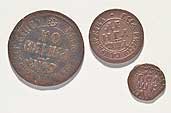
Kopeck. 1706;
Denga. 1704;
Mite. 1701. Copper.
|
After monetary reform of 30th years of 16th century a silver coin "kopeck" become the basic monetary unit. On a new coin has been represented the equestrian with a spear, and by that it differed from old Moscow “denga”, where has been represented the equestrian with a sabre (the image of the horseman with a spear on kopeck has existed till the end of 18th century). The initial weight of silver kopeck made up 0,68 gr. Its weight took from Novgorod “denga”, which was twice heavier than the Moscow one. At this time the rouble was only registration unit, it was equaled 100 Novgorod or 200 Moscow “denga”, or 400 “polushka” (mite) (half of “denga” or a kopeck’s quarter). Each governor, coming to the throne, began release of the coins. The significant amount of kopecks of the different type that has been mint by Russian sovereigns of 16th, 17th and the beginnings of 18th centuries have presented in museum collections, since Ivan Grozny and finishing Peter I (Ill. 3).
Russian coins from 14th century and till 1718 technically represent the original phenomenon. The way of preparation of metal slices for their stamping remained invariable more than 300 years, causing the wrong form of ready coins, which was defined by way of manufacturing of monetary plates from the flattened out slices of a wire. Average diameter of a wire was 3 mm. The wire to flatten shared in weight on the necessary number of parts, has flattened, and then made stamping of a coin by two stamps. Therefore, coins have the wrong oblong form because of which have received the name «scale».
Kopecks - «scale» have existed till 1718. In parallel with them, since 1700, during currency reform spent in Russia by Peter I, there are coins of the various face values which have been let out from copper (“kopeck”, “denga”, “polushka”(mite), “halfpolushka”) (Ill. 4), silver (rouble, “half rouble”, “semi-half rouble”, a ten-kopeck coin, a three-kopecks piece) (Ill. 5-9) and gold (a gold piece, a double gold piece, double rouble) (Ill. 10-11).
|
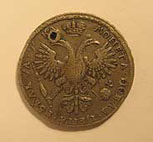
5. One rouble. 1721. Silver.
|
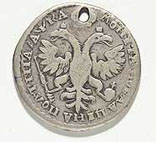
6. The fifty-kopeck piece. 1721. Silver.
|
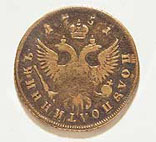
7. The fifty-kopeck piece. 1751. Silver. |
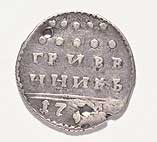
8. The ten-kopeck coin of 1724. Silver.
|
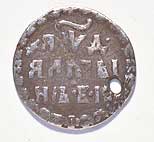
9. The three-kopecks piece of 1704. Silver.
|
|


